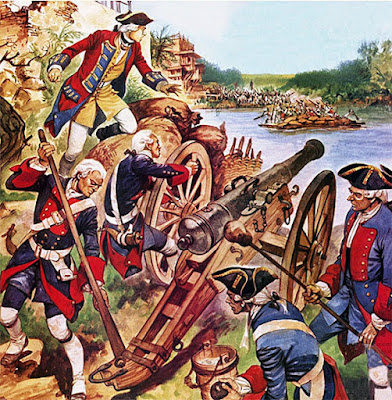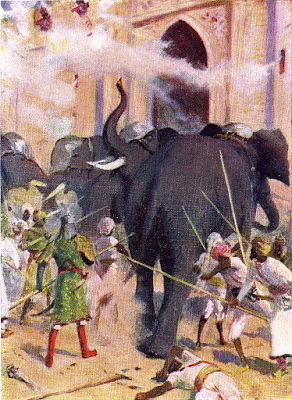 |
| 1751. Arcot Siege, S. India, Robert Clive. britishbattles.com |
 |
| Baron Clive Of Plassey, India. pixels.com |
.That Robert Clive, the man whose behavior was untruly through out his childhood with poor education became the eeliest founder of the British empire in India, is an unexpected historical event. He had no mentor whom he could emulate. Devoid of scholarship, good education and amiable behavior while growing, at one stage of his later life, he took a decision to improve himself to lead a meaningful and adventurous life. Armed with firm determination, while working he had spent much of his time to improve his education and other skills to keep himself safe in his job in a competitive environment. His continued efforts stood him in good stead when he held the most powerful job in India. His good writing skill and speech which he developed in the early part of his career got him a name in the House of Commons in the later years. His speech on the Corruption charges raised by some powerful men regarding his wheeling dealing in Bengal is a good example. .
 |
| 1751 siege of Arcot, S. India. britishbattles.com |
With the help of his father, Robert Clive got a humble position with the EIC. He joined the English company in June 1744 and at that time it had a small settlement at Fort St. George facing the Bay of Bengal near the village of Chennappanayaka Patnam, later Madras now called Chennai (a major Indian city and an IT and automobile manufacturing hub). At Madras for about two years Clive worked as an assistant shopkeeper; it was a sort of clerical job involving book keeping and desk job. Here, his easy access to the library made him a good reader. What made Clive become the first Governor General of India? How did he learn the military and administrative skills to run the mercantile trading company that was to become the proxy government for the British crown in the late 18th century?
The emerging French East India company that had a settlement at Pondicherry, S. India about 110 miles south of Madras on the east coast became an arch rival for the EIC and their influence grew as months went by. During Clive's tenure the French forces raided the English settlement in Madras and captured it in 1746. Clive and others were taken as prisoners by the French. Subsequently, Clive. and others managed to escape from there disguising as natives and mostly traveling at night. After 3 days they reached Ft. David, Cuddalore (now in Tamil Nadu). Built in 1725, the two-story colonial style structure, served as the seat of power of the English on the Coromandel coast.
 |
| Location. Arcot (Tamil Nadu), India weather-forecast.com |
Realizing the necessity to have military training to get better job opportunities, Clive joined the British forces to undergo the needed training there, When in 1747 the French army attacked Fort . David, for the first time Clive took charge of the situation and he successfully managed to defend the fort. Thus he had gained a first-hand experience in war and this exposure made him become a resolute soldier.
After the discovery of the first sea route to India by Vasco de Gama in 1498, the European countries began to land in India and evinced keen interest in the affairs of local rulers, taking advantage of their non cooperation lack of unity among them
After the death of the Nizam of the Deccan, Asaf Jah in 1748, the succession to the Carnatic region (part of present Tamil Nadu and Karnataka) became a disputed issue. The Carnatic region was ruled by the Nizam's agent Nawab Muhammed Ali Khan Wallajah. British who dominated over other European powers gave full support to Nawab Wallajah. On the other hand, the French who were a force to reckon with in this part of India, backed Chanda Sahib, a relative of Wallajah. In the war of succession the French candidate Chand Sahib, son-n-law of Nawab Dhost Khan ultimately won out.
 |
| Siege of Tirchinopoly 1751 by Chanda Sahiben.wikipedia.org |
 |
| death of Anwaruddin Muhd. Khan, Ambur (Carnatic war) en.wikipedia.org |
 |
| Statue of Dupleix, Pondicherry, India en.wikipedia.org |
 |
| French Gov. Gen. Joseph François Dupleix alamy.com |
Above image: Joseph François Dupleix (23 January 1697 – 10 November 1763) , a man of commanding stature was Governor-General of French India and rival of Robert Clive. Under his command the French East India company gave a stiff competition to the EIC operations in Madras and also in Bengal. Widely traveled, his father, a director of the French East India Co hehad sent him on voyages to the Americas and India and in 1720 was named a member of the superior council at Bengal. Using his business acumen on his own, he made many business ventures on the sides and acquired a big fortune. He was the one who turned the succession disputes among the Indian rulers to his advantage and pushed the French influence to the fore......................
As part of consolidation of his throne, Chanda Sahib decided to get rid of his rival, Muhammed Ali Khan Wallajah, who fled to Trichinopoly following the Battle of Ambur in 1749, in which his father Anwaruddin Muhammed Khan was slain. After raising needed funds in 1751, assisted by Joseph François Dupleix, Chanda Sahib led a large force to besiege the fort town of Trichinopoly. Ali was supported by a handful of his own men and about 600 British troops. This siege was not well handled by the EIC;s forces as the English commander lacked the skill to break the siege. The French army gave an effective and adequate support to Chanda Sahib. The political situation at Trichinopoly was in favor of the French and their alley.
 |
| Clive and his army marching to Conjeeveram. indianvagabond.com |
 |
| 1751 Siege of Arcot, S.India.britishbattles.com |
Above image: Siege of Arcot 31st August to 15th November 1751 in the War in India: picture by Cecil Doughty..............................
 |
| Robert Clive at the Arcot Siege S.India.britishbattles.com |
 |
| Siege of Arcot war elephants en.wikipedia.org |
Upon hearing about the capture of his capital Arcot, under the command of his son Raza sahib, Chanda Sahib immediately dispatched 4,000 of his siege force with many Europeans and 300 cavalry to recapture Arcot. At Trichinopoly the siege was finally lifted on 10 April 1751 and Wallajah was released from there. As for Chanda Sahib, he was killed by the Tanjorean forces who supported the British,
Being clever, as he was, Clive who had already put the town of Arcot under his control was satisfied with water supply and the 60 day supply of provision available in the fort. When firing broke out between them and the Arcot forces the British killed 15 French men, but their casualty was low. In the mean time Clive secured big cannons and additional soldiers from Madras to handle the siege on the fort. The French on their part brought powerful guns from Pondicherry and pounded the British positions in the fort . Some British cannons were damaged and the French pounding continued. The siege had lasted more than a month and Clive and his men were low on provisions and ammunition at this point of time. The Arcot forces asked Clive to surrender. The French had additional reinforcement to assist Raza Sahib in the siege. Undeterred and refused to be cowed down, Clive made up his mind to hang on to the fort as long as he could despite heavy pounding from the French forces and the size of Chanda's army. Clive and his men were nearing exhaustion. A tough job for his men to defend the damaged fort that was open with just a moat separating the fields on three sides and the Palar river on the other side. Clive then knew that if he had to win the battle, then he had to defend his position against the Arcot forces.
 |
| War elephants in the siege of Arcot, S.India.britishbattles.com |
Above image: Elephants with iron plates on the front part of the head ramming at the gates of Arcot Fort: Siege of Arcot, 1751.........................
Raza sahib with the help of the French army decided to go for the final assault on 14th November 1751 and luckily Clive got the prior information from the spy about the imminent attack. Spearheaded by war elephants with iron plates on the forehead to storm the fort's gate, Arcot's huge army moved forward. Unexpectedly, the elephants panicked upon the firing of musket-balls and ran amok trampling on innumerable army men. Heavy firing from the British on the Arcot soldiers on the dry moat caught them unaware and after an hour or so 400 Arcot soldiers fell to the shelling but the English casualty was low.
The unpredicted 52 day long siege at Arcot was well handled by Robert Clive despite odds and lack of war experience. But, his military strategies in Arcot against a formidable army provided him a chance to improve and experiment his war strategies, depending on the emerging odd situation on the war front. Clive dwelled into the realm of fundamentals of military scouting, planning, offensive, defensive strategies, maneuvers, anticipation, contingency plan, etc. Clive also got a chance to know all about the siege by the enemies and the survival skills in case the siege lasted for a long time.
When emerged out of Arcot town the deserving victory gave Clive more confidence than ever before to handle any odds on the war fronts. It was a remarkable show of efficiency, patience and quack planning despite the challenges by someone who was not a professional army man To him sheer guts and commitments were an added advantage. The British finally installed Muhd Wallajah on the throne and Arcot came under their control. Clive's tactical military strategy and its execution at Arcot won him laurels and he became a war hero. His string of successes in the later years was phenomenal. Subsequently, after the battle of Plassey - 3 June 1757 and Buxar - 22 October 1764 Clive captured Bengal in NE India, consolidated the British supremacy. Thus he laid the first foundation of the British Empire in India. The English economy, with poor GDP - around 03, had begun to grow, causing the Indian economy with a strong GDP - roughly 23 to slide downhill. After persistent sacrifices, toil and pain for centuries India became a free country on 15 August, 1947.
https://indianvagabond.com/2016/09/19/delhi-gate-arcot-the-beginning-of-robert-clive








